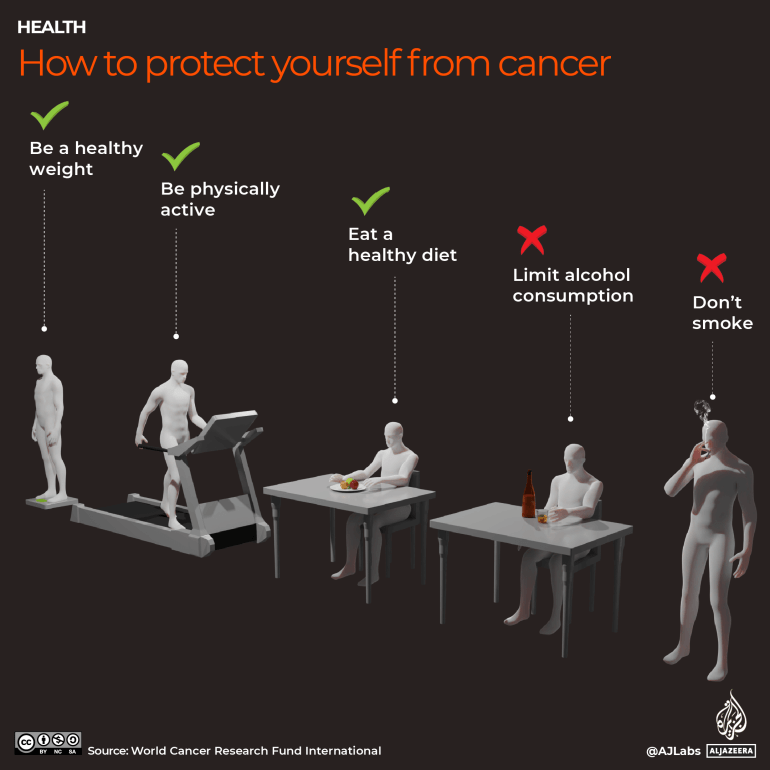Infographic: A global look at cancer
In 2020, more than 18 million people around the world were diagnosed with cancer.
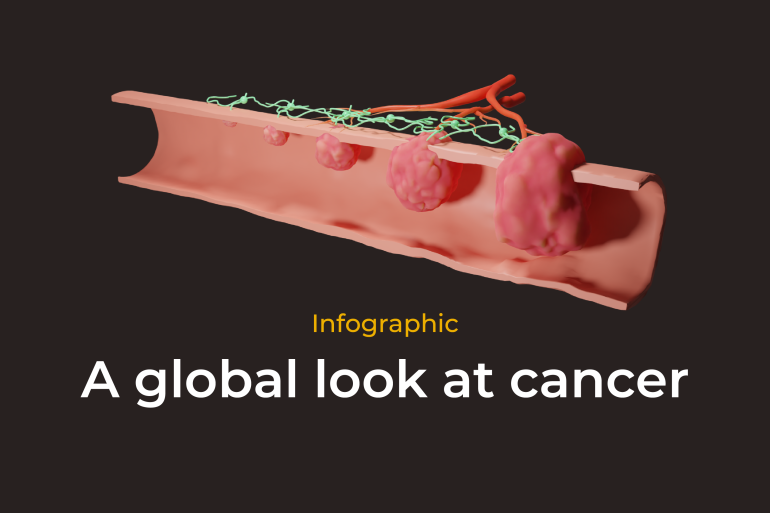
February 4 marks World Cancer Day – an annual global initiative to raise awareness about prevention, detection and treatment against one of the world’s leading causes of death.
In 2020, more than 18 million people were diagnosed with a form of cancer. Of these, 9.3 million cases were in men and 8.8 million in women.
Keep reading
list of 3 itemsPhotos: Sri Lanka’s cancer patients struggle amid economic chaos
Tennis great Navratilova vows to fight double cancer diagnosis
In the following infographic series, Al Jazeera takes a look at one of the world’s largest health problems.
How does cancer develop?
The human body consists of trillions of cells. Every day, new cells grow and multiply in a process called cell division. A normal cell first grows, then divides and finally dies.
Cancer cells, on the other hand, undergo genetic changes leading them to divide uncontrollably. These cells can then invade nearby tissues and spread to other parts of the body.
The development of cancer is measured in stages and is determined by a few different factors, including the size and location of the tumour:
Cancer stages:
Stage 0: Abnormal cells are present but have not spread to nearby tissues.
Stage 1 (early-stage): Cancer has not infiltrated deeply into nearby tissues, nor has it spread to lymph nodes or locations away from the primary tumour.
Stage 2 (localised): Tumour cells have spread deeper into neighbouring tissues, but not to distant sites in the body.
Stage 3 (regional spread): Cancer has grown more deeply into neighbouring tissues and spread to lymph nodes but has not spread to distant sites in the body.
Stage 4 (distant spread): Cancer cells have spread beyond nearby tissues and into lymph nodes and parts of the body, including organs, potentially far from the original site. This stage is often referred to as advanced cancer.
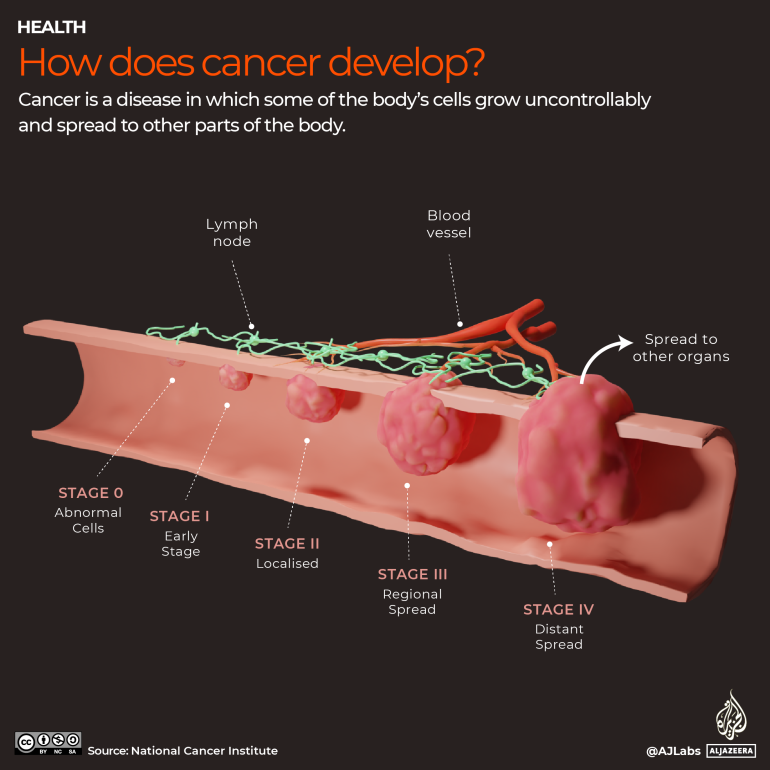
The most common types of cancer
According to the US-based National Cancer Institute, there are more than 100 different types of cancer.
Cancer can start almost anywhere in the body, including bones, organs and skin. The types of cancer are usually named after the organs or tissues where they originate.
The two most common types of cancer worldwide are breast and lung cancer, contributing 12.5 percent and 12.2 percent, respectively of the total number of new cancer diagnoses in 2020, according to the World Health Organization (WHO).
Lung cancer is the most common type of cancer among men, contributing 15.4 percent of all new cancer diagnoses in 2020. Among women, breast cancer is the most common, accounting for about one-quarter (25.8 percent) of the total new cases in 2020.
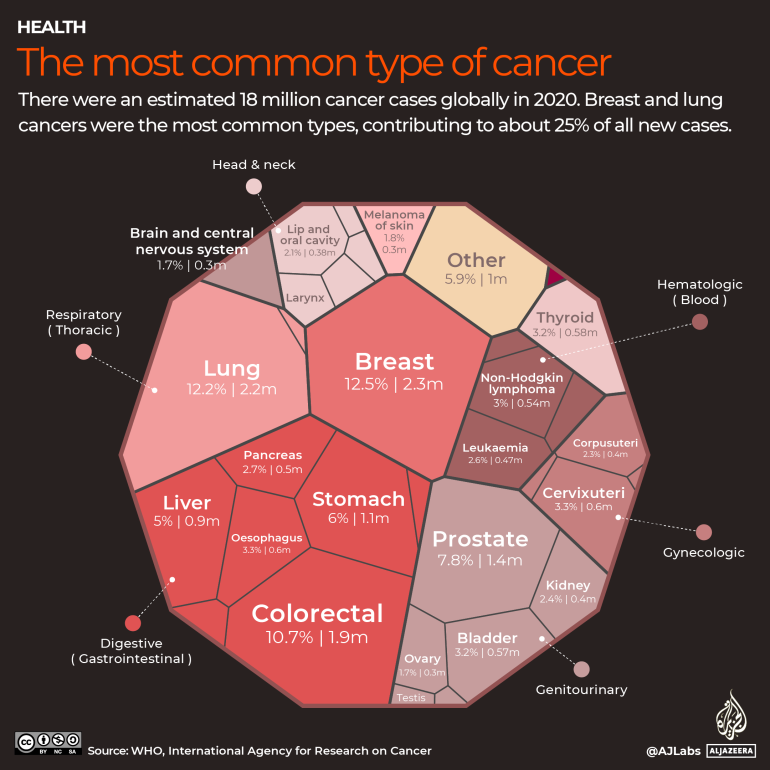
How many people die from cancer?
Not all cancers cause death. However, it is important to identify and treat cancer as early as possible. When identified early, cancer is more likely to respond to treatment and can result in a greater chance of survival.
In addition to early diagnosis, cancer screening is an effective way of identifying abnormal cells before they may become cancer. Several screening tests have been shown to detect cancer early and to reduce the chance of dying from that cancer.
In 2019, more than 10 million people died from cancer around the world, making it the second leading cause of death after cardiovascular diseases, according to the Institute for Health Metrics and Evaluation (IHME). Almost half, 46 percent, of all people who die from cancer are aged 70 or older.
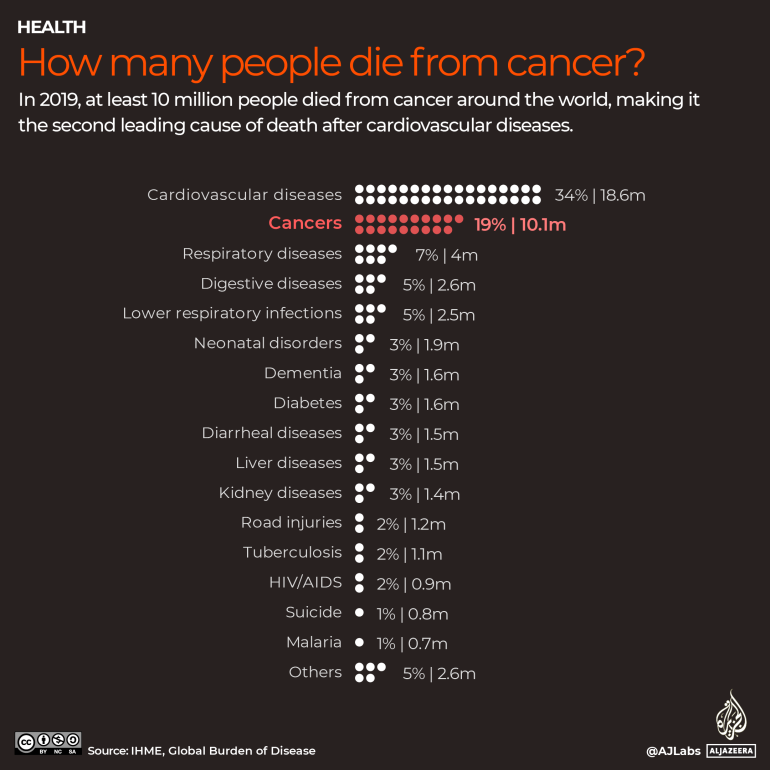
Most common cancer deaths
The most common cause of cancer death is lung cancer, accounting for 1.8 million deaths worldwide in 2020, according to the WHO. The second most common cause is colorectal cancer (935,173 deaths), followed by liver cancer (830,180 deaths) and stomach cancer (768,793 deaths).
About one-third of deaths from cancer are due to tobacco use, high body mass index, alcohol consumption, low fruit and vegetable intake, and lack of physical activity, the WHO says.
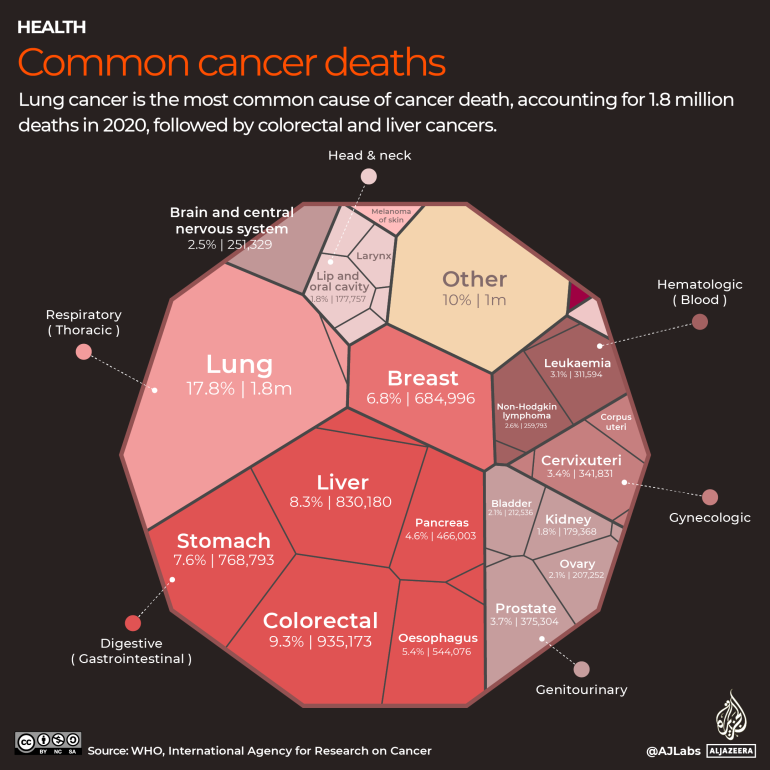
Cancer rates across the world
According to the World Cancer Research Fund International (WCRF), 18,094,716 cases of cancer were diagnosed globally in 2020.
The age-standardised rate for all cancers diagnosed in 2020 was 190 per 100,000 people. The rate was higher for men (206.9 per 100,000) than for women (178.1 per 100,000).
In 2020, the highest cancer rate was in Denmark at 334.9 people per 100,000, followed by Ireland (326.9 per 100,000) Belgium (322.8 per 100,000), Hungary (321.6 per 100,000) and France (320.1 per 100,000).
Hover over the countries below on the map to view each country’s cancer incidence:
Treating cancer
Cancer is a complex group of diseases, each behaving differently on a genetic and molecular level. Not every cancer cell in a tumour is identical, which means treating a cancer patient may involve several different approaches.
The three most common types of treatment for cancer are surgery, chemotherapy and radiotherapy.
Surgery
A cancer tumour that has not spread can be surgically removed. A surgeon removes the tumour that is contained in one area. Sometimes, surgery is not possible, such as with cancer of the blood or lymphatic system.
Chemotherapy
Not all cancers can be cut out; in such cases, doctors use other therapies, such as chemotherapy. Chemotherapy, often shortened to “chemo”, is the use of strong drugs to kill cancer cells. If the disease has spread in the body, or it is likely to spread, chemotherapy drugs are often used.
Radiotherapy
Radiation therapy is a form of treatment that uses high-energy rays or particles to kill cancer cells. While both healthy and cancerous cells are damaged by radiation therapy, the goal is to destroy as few healthy cells as possible.
Hormone therapy
Sometimes a doctor may prescribe hormone pills that a patient may have to take for a duration after their treatment has finished. This is to stop cancer cells from starting to grow again. Hormones can also be given as a monthly injection or drip.
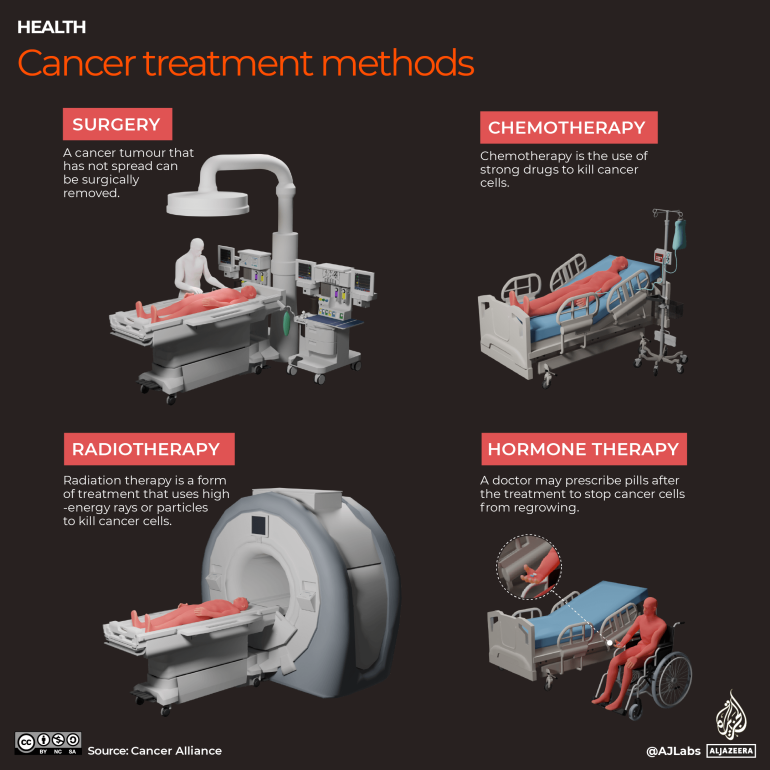
How to protect from cancer
According to the WHO, 30-50 percent of cancers can be prevented by avoiding risk factors and implementing evidence-based prevention strategies. These include:
Don’t smoke
Smoking is the single biggest risk factor for developing lung cancer. Smoking introduces many chemicals that get into the bloodstream which can lead to cancer almost anywhere in the body.
Maintain a healthy weight
Being overweight or obese has been linked with a higher risk of getting several types of cancer. The risk is proportional to the gain of excess weight and its duration.
Active lifestyle and better diet
Forming healthy eating habits can help reduce the risk of cancer and aid in the body’s immune system. Doctors recommend getting 150-300 minutes of moderate-intensity activity each week. Move more and sit less.
Limit alcohol consumption
The less alcohol you drink, the lower your risk for cancer. Drinking alcohol can damage the body’s DNA and prevent the body from repairing itself.
